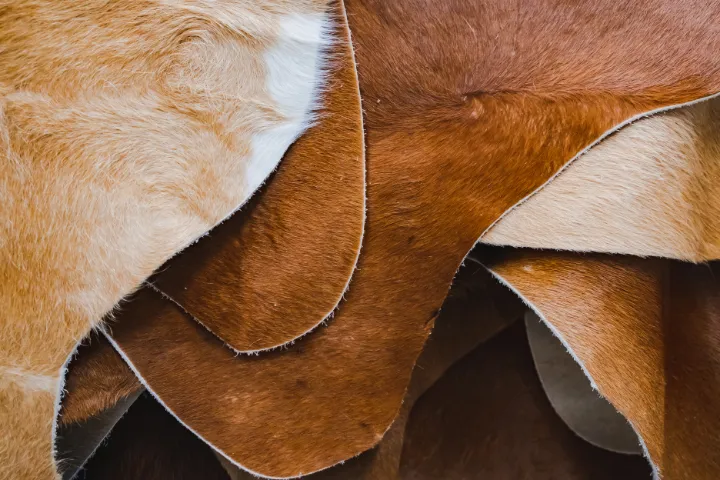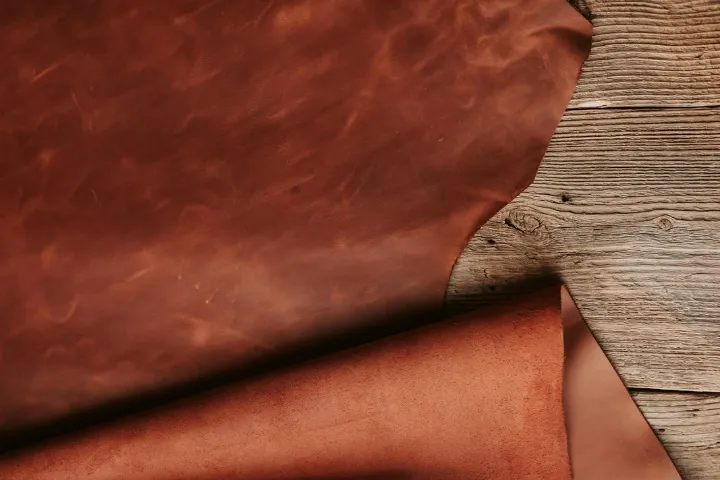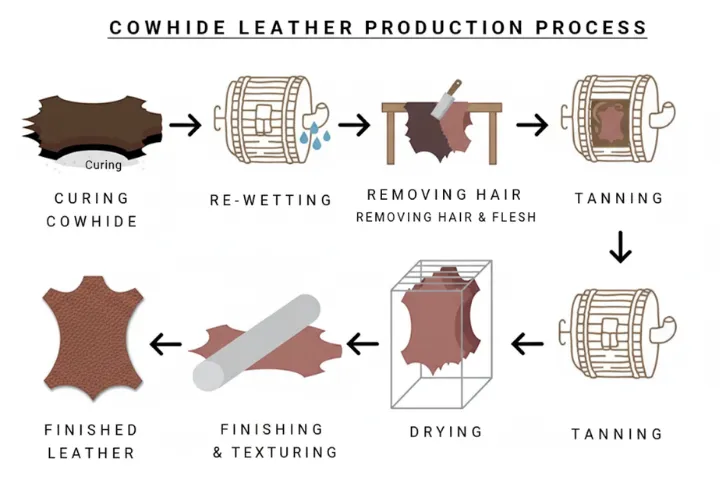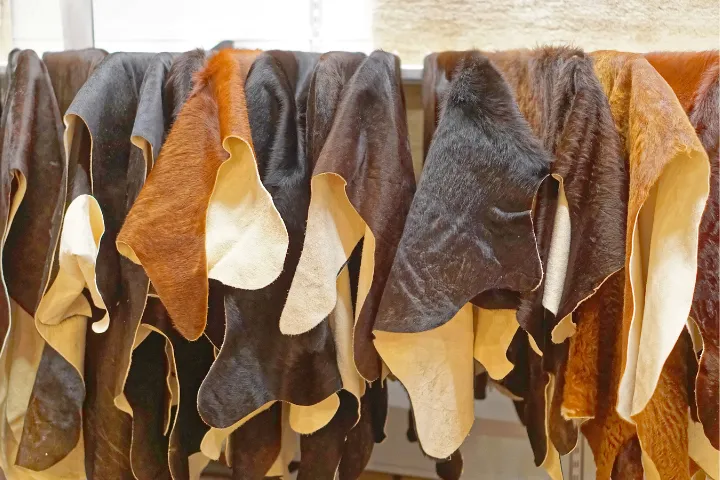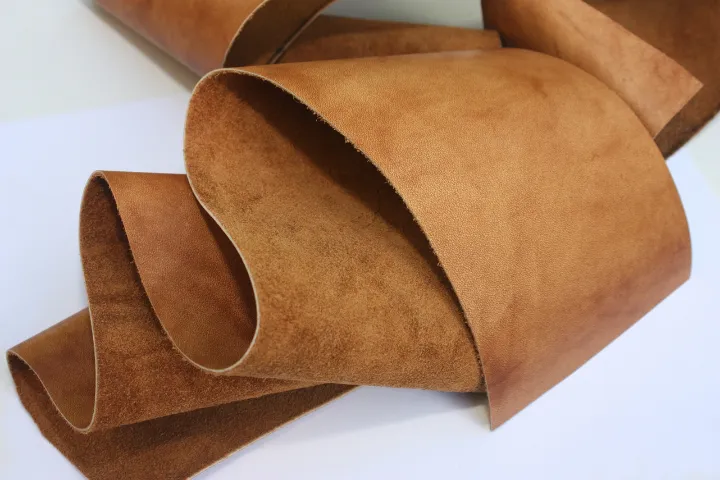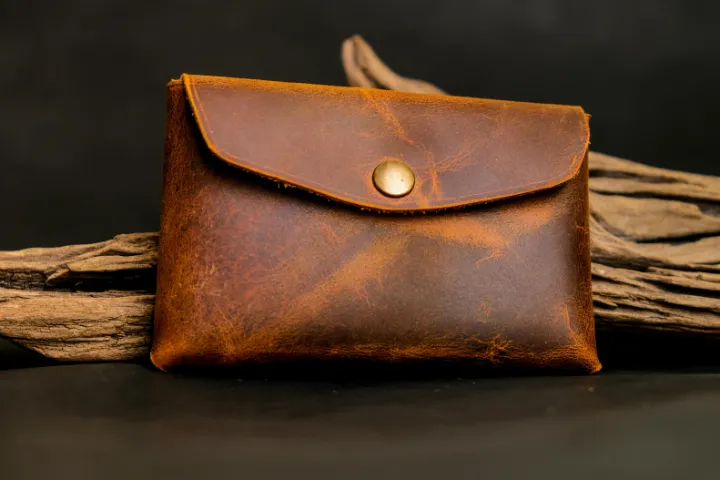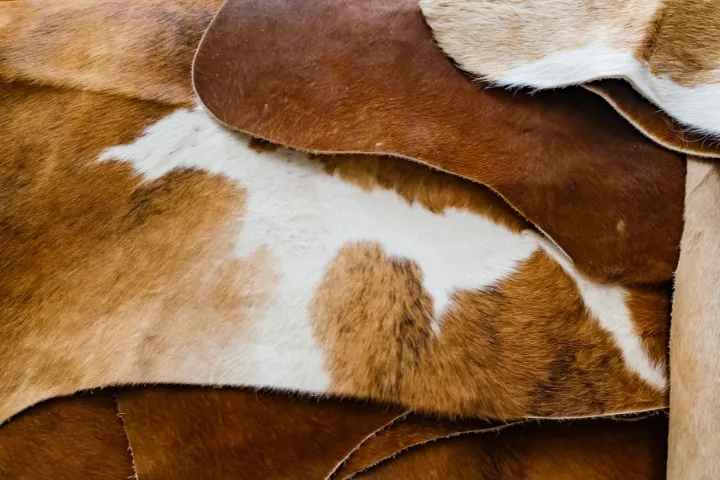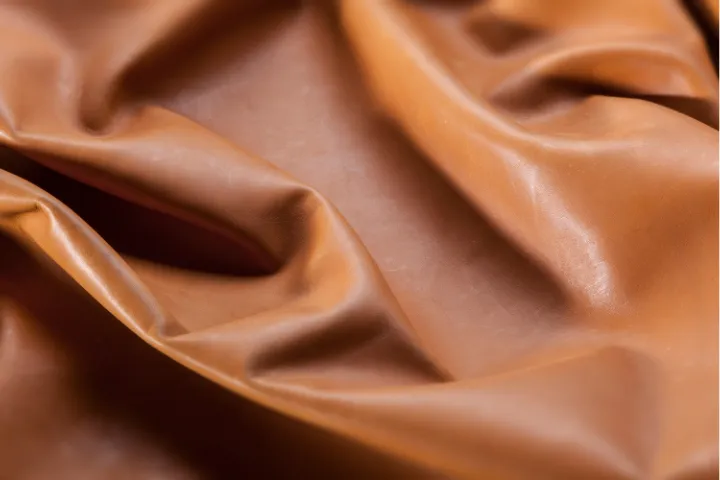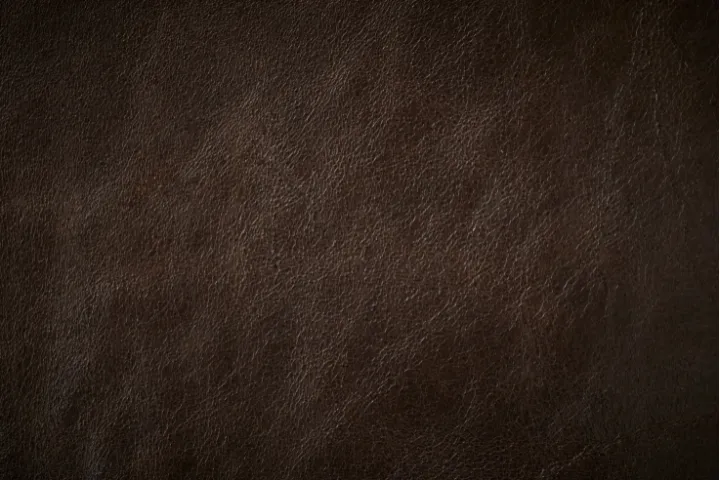Think about your favorite leather jacket, a comfortable sofa, or a sturdy pair of boots. Chances are, cowhide forms the foundation of them all. For centuries, cowhide has been the workhorse of the leather world, prized for its timeless appeal and incredible versatility. It’s a material that can be rugged and tough or smooth and luxurious. This unique adaptability is why designers and craftsmen rely on it to create some of the most iconic products we use every day.
Cowhide leather is the natural, unbleached skin of a cow that tanners have preserved into a durable material. It is the most common type of leather in the world, valued for its unique combination of strength and flexibility. The grade of the hide, such as full-grain or top-grain, determines its quality and durability, making it suitable for everything from rugged furniture to high-end fashion.
But what really is cowhide leather? How do manufacturers make it, and what makes one type better than another? This guide is your complete, professional resource. We will explore everything from its historical origins and modern production processes to the different grades and uses of this amazing material. By the end, you will understand what makes cowhide the industry standard and how to choose the perfect product for your needs.
The Origins and History of Cowhide Leather
Cowhide is not a new invention. Its story is as old as human civilization itself. For thousands of years, people have relied on the strength and durability of this amazing material. It began as a material of pure necessity and has since evolved into a staple of both high fashion and everyday function, shaping human history along the way.
From Ancient Necessity to Modern Staple
Early humans quickly learned the value of cattle hides. They provided essential protection from the elements. Ancient civilizations used raw cowhide for simple shelters, rudimentary clothing, and basic footwear. Because of its thickness and toughness, it was also perfect for creating armor and shields for warriors. This long history proves cowhide’s natural ability to withstand heavy use, making it the original performance material, valued for its pure function and reliability.
Cowhide as a Sustainable Byproduct
The journey of cowhide is closely tied to agriculture. As humans began domesticating cattle for meat and milk, a new and valuable resource became widely available: the skin. Instead of discarding the hides, people repurposed and preserved them. This makes cowhide one of the oldest examples of sustainable upcycling. It transforms a byproduct of the food industry into a durable, long-lasting good. This practical relationship has made cowhide so abundant and cemented its place as the world’s most common leather.
Key Milestones in Tanning Techniques
The biggest revolution in cowhide’s history was the development of tanning. This is the process that turns a raw, perishable hide into the stable, permanent material we know as leather.
- Ancient Vegetable Tanning: For centuries, tanners used the oldest method, known as vegetable tanning. This slow process used natural tannins from tree bark and plants. It took months to produce a strong, firm leather, which was perfect for making things like saddles and belts.
- The Industrial Shift to Chrome Tanning: The Industrial Revolution brought a massive breakthrough. In the mid-1800s, inventors created chrome tanning. This new chemical process could tan a cowhide in just a few days. This incredible speed made high-quality cowhide leather affordable and accessible to everyone. It fueled the growth of the modern shoe, bag, and upholstery industries, making cowhide the versatile material we all rely on today.
What is Cowhide Leather?
At its simplest, cowhide leather is the natural, tanned hide of a cow. The term “cowhide” specifically refers to leather from bovine animals, making it the most common and recognizable type of leather on the planet. However, it’s important to distinguish between the raw material and the finished product that we see in stores.
Raw Cowhide vs. Finished Leather
The term “cowhide” can refer to two different things, which often causes confusion. Here’s a simple breakdown:
- Raw Cowhide: This is the unprocessed skin of a cow, often with the hair still attached. People might use this form for decorative items like rugs or wall hangings. Processors have treated it for preservation but have not turned it into a pliable material for making goods.
- Finished Cowhide Leather: This is what we usually mean when we talk about cowhide. The raw hide has gone through the full tanning and finishing process. Tanners have removed the hair and transformed the skin into a strong, flexible, and durable material ready to be crafted into products.
Is cowhide leather real leather? Yes, absolutely. Cowhide is 100% real leather. The term “genuine leather” can be confusing because marketers often use it as a label for a lower grade of leather. However, cowhide itself is simply the source of the leather. A product made from full-grain cowhide is one of the highest quality leather goods you can buy.
Cowhide dominates the global market because of its availability. As a byproduct of the massive global meat and dairy industries, it is far more abundant than any other type of animal hide. Statistics show that cowhide makes up over 65% of all leather produced in the world. This makes it a reliable and cost-effective choice for manufacturers, which is why you find it in such a huge variety of products.
The Cowhide Leather Production Process
Transforming a raw cowhide into the beautiful, durable leather we use every day is a complex, multi-stage process. It involves careful preparation, a crucial tanning phase, and a series of finishing touches that give the leather its final look and feel. Each step requires a blend of traditional craftsmanship and modern technology to ensure a high-quality result.
Preparation: From Raw Hide to “Pickled” Pelt
Before tanning can begin, tanners must thoroughly clean and prepare the raw, salted hide. This ensures the tanning agents can penetrate the skin evenly. This stage includes several key steps:
- Soaking and Liming: Tanners rehydrate and clean the hide in large vats. They add lime to help remove hair and fats.
- Unhairing and Fleshing: A machine removes the hair and any remaining flesh or fat from the inner side of the hide.
- Deliming and Bating: Tanners neutralize the hide to remove the lime and add enzymes to soften the collagen fibers, making the final leather more supple.
Tanning Techniques in Depth
Tanning is the heart of the leather-making process. It permanently preserves the hide. The two dominant methods, chrome and vegetable tanning, produce very different results.
- Chrome Tanning: This is the most common method, making up over 80% of the world’s leather. It uses chromium salts to tan the hide in as little as one day.
- Pros: It’s fast, affordable, and produces a soft, supple leather that is water-resistant and holds color well.
- Cons: It has a significant environmental impact if tanneries do not properly treat the wastewater.
- Vegetable Tanning: This ancient method uses natural tannins from plants. It is a slow, artisanal process that can take months.
- Pros: It’s eco-friendly and creates a firm, durable leather that develops a beautiful patina over time.
- Cons: It’s expensive, time-consuming, and the leather is not as soft or water-resistant as chrome-tanned options.
Finishing: Creating the Final Look and Feel
After tanning, the leather is known as “crust.” It then goes through a series of finishing processes to achieve its final appearance.
- Splitting and Shaving: A machine splits the thick hide into layers and shaves it to a uniform thickness.
- Dyeing: Tanners color the leather in large drums to achieve the desired shade.
- Staking and Drying: Workers soften the leather by tumbling it with sawdust and then stretch it to dry.
- Final Coating: Tanners may apply a protective topcoat to add water resistance or emboss a pattern on the surface.
Throughout this journey, reputable manufacturers implement strict quality control. They ensure that every hide meets standards for thickness, color, and strength, and that they follow all environmental regulations.
Types and Grades of Cowhide Leather
Not all cowhide is the same. Its quality, durability, and appearance depend entirely on which layer of the hide it comes from and how manufacturers process it. This grading system creates a clear hierarchy, from the most premium and natural to the most processed and affordable. Understanding these grades is the single most important skill for a smart leather buyer.
Full-Grain Cowhide Leather
This is the best of the best. Full-grain is the highest quality grade of cowhide. It comes from the top layer of the hide and includes the full, natural grain. Manufacturers do not sand or buff the surface, so it retains all the original markings and dense fibers that make it incredibly strong. It develops a beautiful patina over time, making it the top choice for heirloom-quality goods.
Top-Grain Cowhide Leather
Top-grain is the second-highest quality grade. Like full-grain, it comes from the top layer of the hide. However, tanners lightly sand its surface to remove imperfections like scars or insect bites. This process creates a more uniform, flawless appearance. While slightly less durable than full-grain, it is more stain-resistant and affordable, making it a very popular choice for luxury handbags and accessories.
Split Leather and Suede
When tanners split the top-grain off a hide, the bottom layer is called split leather. It is less durable because it does not have the dense grain fibers of the top layer. However, it is very versatile. The most common use for split leather is to create suede. By sanding the surface of the split, tanners create the soft, velvety nap that suede is famous for. Tanners can also coat and emboss split leather to look like a higher grade.
Other Variations: Bonded, Corrected-Grain, and Specialty Finishes
Beyond the main grades, there are other important variations:
- Corrected-Grain: This is a type of top-grain leather that has been heavily sanded to remove many imperfections. Tanners then emboss an artificial grain onto the surface.
- Bonded Leather: This is the lowest quality. Manufacturers make it from leftover leather scraps that they shred and glue together onto a backing sheet. It is not durable and is prone to peeling.
- Specialty Finishes: High-quality full-grain and top-grain cowhide can also have specialty finishes. Tanners use transparent dyes for Aniline leather to show the natural grain, while they sand Nubuck on the grain side for a velvety feel that is more durable than suede.
Physical Properties and Characteristics of Cowhide Leather
People prize cowhide for a specific set of physical properties that make it uniquely suited for a wide range of applications. Its strength, breathability, and ability to age gracefully are all rooted in its natural structure. Understanding these characteristics helps explain why it has remained a dominant material for centuries.
Durability and Longevity Factors
Cowhide is exceptionally tough. This durability comes from the dense collagen fibers in the corium. Here are some key metrics:
- Tensile Strength: This measures the force needed to pull the leather apart. Cowhide has a high tensile strength, typically ranging from 8 to 25 N/mm². This is why it rarely tears.
- Elongation: This is its ability to stretch without breaking. Cowhide can stretch significantly (42-52.9%), which allows it to mold to shapes and resist damage from flexing.
Compared to most synthetic materials, a high-quality cowhide product will last far longer. A full-grain cowhide bag or jacket can easily last for decades with proper care, far outliving its faux-leather counterparts.
Environmental Resistance
Cowhide’s performance in different environments depends on its grade and tanning method. The natural grain structure provides good heat insulation, making it comfortable to wear in both warm and cool weather. Its breathability also allows moisture to escape, which is why it’s so popular for footwear.
Does cowhide leather get wet? Yes, it can. While naturally water-resistant, cowhide is not waterproof. Light rain will bead up on the surface, but a heavy downpour will eventually soak in. Chrome-tanned cowhide offers better water resistance than vegetable-tanned, but both benefit from a protective spray to prevent water spots and damage.
Advantages and Disadvantages of Cowhide Leather
Like any material, cowhide has a distinct set of pros and cons. Its strengths have made it a timeless staple, but its weaknesses mean it isn’t the right choice for every situation. A balanced view helps you appreciate where cowhide truly shines and where other materials might be a better fit.
Advantages of Cowhide Leather
Cowhide’s popularity is built on a foundation of clear, powerful benefits. These advantages are why it continues to be the most trusted leather for a huge range of goods.
- Incredible Strength: Its dense fiber structure makes it one of the most durable materials available. A full-grain cowhide wallet, for example, can withstand daily use for years without tearing.
- Versatility: Tanners can make it firm and rugged for a work boot or soft and supple for a luxury handbag.
- Comfort and Breathability: As a natural material, it breathes well, making it comfortable for clothing, shoes, and furniture.
- Timeless Aesthetic Appeal: High-quality cowhide develops a beautiful patina over time, gaining character with age.
- Value Retention: Products made from premium cowhide hold their value well and represent a long-term investment.
Disadvantages of Cowhide Leather
Despite its strengths, cowhide also has several notable drawbacks. You should consider these important points before making a purchase.
- Higher Cost: Premium grades like full-grain are expensive due to the quality of the hide and the labor-intensive process.
- Maintenance Needs: Natural cowhide requires regular cleaning and conditioning to prevent it from drying out and cracking.
- Weight: Its durability comes with a trade-off: cowhide is a heavy material, which can be a downside for large bags or jackets.
- Ethical and Environmental Concerns: The production process raises valid concerns about animal welfare and the environmental impact of tanning.
Common Uses and Applications of Cowhide Leather
Cowhide’s unique combination of strength and versatility makes it the most widely used leather across numerous industries. From the fashion runway to the family living room, its presence is a mark of quality and durability. Its ability to be finished in countless ways allows it to fit nearly any aesthetic, securing its spot as an essential material for high-quality goods.
Fashion: From Jackets to Footwear
In the fashion world, cowhide is a cornerstone material. It provides the structure for classic items built to last.
- Jackets, Bags, and Belts: A thick, full-grain cowhide is perfect for a rugged motorcycle jacket or a durable belt that will last a lifetime.
- Wallets and Footwear: Top-grain cowhide, with its uniform finish, is ideal for creating polished dress shoes and elegant wallets.
Furniture, Upholstery, and Automotive
The large size and incredible toughness of cowhide make it the top choice for covering surfaces that see a lot of wear. A cowhide sofa can handle decades of family life. In the automotive world, its durability makes it perfect for car interiors and steering wheels, offering a touch of luxury that can withstand constant use. Designers often use hair-on cowhide to make distinctive and durable rugs for a rustic aesthetic.
Other Common Uses
Cowhide’s applications don’t stop there. You can find it in a huge range of other products, including:
- Accessories: Such as watch straps and journal covers.
- Sporting Goods: Including baseball gloves and saddles, which require extreme durability.
- Industrial Uses: Manufacturers often make heavy-duty work gloves and safety aprons from thick, tough split-grain cowhide.
Emerging Trends in Cowhide Usage
Today, designers are finding new ways to innovate with this traditional material. There is a growing trend toward using vegetable-tanned, full-grain cowhide from ethically certified sources. Modern brands are also embracing its natural imperfections, celebrating the unique character of each hide rather than correcting it. This shift reflects a broader consumer demand for authentic, sustainable, and long-lasting products.
How Cowhide Leather Compares to Other Types of Leather
While cowhide is the industry standard, it’s not the only option. Understanding how it stacks up against other popular leathers helps highlight its specific strengths and weaknesses. The best choice often depends on whether you prioritize durability, softness, or a lightweight feel.
Cowhide vs. Sheepskin/Lambskin
This is a classic trade-off between toughness and softness.
- Cowhide: Thicker, heavier, and significantly more durable. It’s built for rugged, everyday use.
- Sheepskin: Incredibly soft, supple, and lightweight. People prize it for its luxurious feel, but it is far more delicate and prone to stretching.
Cowhide vs. Goatskin
Goatskin offers a unique middle ground. It is softer and lighter than cowhide but surprisingly strong for its weight. Its distinctive pebbled texture makes it naturally water-resistant and durable. However, cowhide is still thicker and better suited for heavy-duty applications, and it offers superior heat insulation.
Cowhide vs. Pigskin
Pigskin is a durable and breathable alternative, which you can often recognize by the visible pores on its surface. While tough, it has a rougher texture and is generally thinner than cowhide, making it a popular choice for linings and gloves rather than the main body of a product.
Cowhide vs. Synthetic or Faux Leather
This is the classic debate between genuine and imitation. High-quality cowhide offers unmatched longevity, breathability, and develops a rich patina that synthetics cannot replicate. Faux leather is cheaper and cruelty-free, but it is made from plastic, does not breathe, and is prone to cracking and peeling over time. In the long run, a quality cowhide product is a better investment.
Sustainability, Ethics, and Sourcing of Cowhide Leather
In today’s market, quality is about more than just durability. Consumers and brands are increasingly focused on the ethical and environmental impact of their products. While the leather industry has faced criticism, a growing movement towards responsible sourcing is making cowhide a more sustainable choice than ever before.
Ethical Sourcing: The Byproduct Advantage
A key ethical advantage of cowhide is that it is a byproduct of the meat and dairy industries. Farmers raise cattle primarily for food, not for their skins. This means that using the hide is a form of upcycling that prevents a valuable material from going to waste. This makes it a fundamentally different and more sustainable choice compared to exotic leathers or furs, where animals are often raised exclusively for their skins.
Environmental Impact and Modern Solutions
The biggest environmental challenge for cowhide is the tanning process. Traditional chrome tanning can be harmful if not managed properly. However, the industry is innovating to address this:
- Vegetable Tanning: This eco-friendly method uses natural plant tannins, avoiding harsh chemicals.
- LWG Certifications: The Leather Working Group (LWG) is a global organization that audits tanneries for their environmental performance. Choosing leather from an LWG-certified tannery ensures that the producer follows strict standards for water use, waste management, and chemical handling.
By opting for vegetable-tanned or LWG-certified cowhide, you can support a more sustainable and responsible leather industry. This ensures you get a high-quality product while minimizing its environmental footprint.
How to Identify Genuine Cowhide Leather
With so many grades and imitations on the market, knowing how to spot authentic, high-quality cowhide is a valuable skill. You don’t need to be an expert to make a smart choice. By using your senses and checking a few key details, you can easily distinguish a quality product from a cheap fake.
Visual and Tactile Tests
The best clues are right at your fingertips. High-quality cowhide has a look and feel that synthetics can’t replicate.
- Look for Pores and Imperfections: Real cowhide has natural pores and small imperfections. If the grain pattern is too perfect and uniform, it’s likely an artificial embossing.
- Test the Flexibility: Press your finger into the leather. Real cowhide will wrinkle under pressure, like skin. Faux leather will often just dimple and feel stiff.
Professional Tests: Smell and Burn
For professionals, a couple of other tests can confirm authenticity. The smell test provides a great indication; real cowhide has a rich, earthy scent, while fakes often have a plastic or chemical odor. A burn test (done on a hidden edge with extreme caution) will cause real leather to char and smell like burning hair, while faux leather will melt and smell like burning plastic.
Label Reading and Avoiding Fakes
Finally, always read the label. Look for terms like “Full-Grain Cowhide” or “Top-Grain Cowhide.” Be wary of vague terms like “Man-Made Materials.” Buying from a reputable seller is the best way to avoid fakes and ensure you get the quality you paid for.
Care, Maintenance, and Cleaning of Cowhide Leather
A high-quality cowhide product is an investment that can last a lifetime, but only with proper care. Like our own skin, leather needs cleaning and moisturizing to stay in top condition. A simple and consistent maintenance routine will prevent damage and keep your cowhide looking its best for decades to come.
Daily Care and Conditioning
The most important part of cowhide care is keeping it from drying out. Dry leather is what leads to cracking. Here’s how you can prevent it:
- Dust Regularly: Wipe your cowhide items with a soft, dry cloth to remove dust and dirt that can be abrasive.
- Condition Every Few Months: Apply a high-quality leather conditioner or a natural oil, like mink oil, with a clean cloth. This restores moisture and keeps the leather supple. This is also the best way to soften cowhide that has become stiff.
Cleaning Stains and Water Exposure
Accidents happen. If you get a stain, act quickly. Blot liquid stains immediately with a clean cloth. For tougher stains, use a cleaner specifically designed for leather. If your cowhide gets wet, let it air dry naturally. Never use a hairdryer, as the intense heat will cause the leather to shrink and crack.
Proper Storage Tips
How you store your cowhide is crucial for preventing damage. To avoid cracking, always store it in a cool, dry place away from direct sunlight or heat. Use a breathable cotton dust bag for handbags, and stuff them with paper to maintain their shape. For jackets, use a wide, padded hanger to support the shoulders and prevent stretching.
Buying Guide: Choosing the Best Cowhide Leather Products
When you are ready to buy a cowhide product, a little knowledge goes a long way. Understanding the key factors of quality will help you find a piece that offers the best value for your money. A smart purchase is an investment that will last for years, so it pays to choose wisely.
Factors to Consider
Before you buy, evaluate these four key elements to ensure you are getting a quality product:
- Grade: This is the most important factor. Always opt for full-grain or top-grain for the best durability and appearance.
- Thickness: The thickness of the leather, which tanners measure in ounces, often indicates its durability. A thicker leather is great for a sturdy belt, while a thinner one is better for a lightweight bag.
- Finish: Decide if you want a natural, aniline finish that will show wear, or a pigmented, corrected-grain finish that is more resistant to stains.
- Origin: While not always a guarantee of quality, people know some regions like Italy and Brazil for producing exceptional cowhide.
Price Ranges and Value
Price often reflects quality. Expect to pay a premium for full-grain and vegetable-tanned cowhide. While cheaper options like “genuine leather” might be tempting, they offer poor value because they will not last. A high-quality cowhide product is a better long-term investment that provides a much lower cost-per-wear over its lifetime.
Frequently Asked Questions (FAQs)
Is cowhide leather good quality?
Yes, but its quality depends on the grade. Full-grain cowhide is the highest quality leather available, prized for its durability and natural beauty. Top-grain cowhide is also excellent and offers a more uniform look. However, lower grades like “genuine leather” made from cowhide are not considered good quality.
What is the difference between cowhide and genuine leather?
“Cowhide” refers to the source of the leather (a cow), while “genuine leather” refers to a low grade of leather made from the inner layers of a hide. A manufacturer can make a product from genuine leather that comes from a cowhide, but it will not be durable. Always look for full-grain or top-grain cowhide instead.
How long does cowhide leather last?
With proper care, high-quality cowhide leather can last for decades. Full-grain cowhide is particularly known for its longevity and can easily become an heirloom item. Lower grades will wear out much faster.
Can cowhide leather get wet?
Cowhide is naturally water-resistant but not waterproof. Light moisture will bead off, but it will absorb water if exposed for too long, which can cause stains or stiffness. It’s best to apply a protective spray for added resistance.
Is cowhide leather expensive?
The price varies by grade. Full-grain and top-grain cowhide are expensive because they are premium materials. Lower grades like split or genuine leather are much more affordable. In general, its price reflects its quality and durability.
How to spot fake cowhide leather?
Look for an irregular, natural grain pattern—fakes often have a repeating, uniform texture. Real cowhide has a rich, earthy smell, while fakes smell like plastic. Finally, real cowhide feels supple and will wrinkle under pressure, unlike stiff synthetic materials.
Which is better: Cowhide or other leathers?
It depends on the use. Cowhide is better for durability and all-purpose strength. Sheepskin is better for softness and lightweight clothing. Goatskin offers a good balance of both. For most everyday items, cowhide is the best all-around choice.
Conclusion
Cowhide leather has earned its place as the world’s most trusted and versatile leather for a reason. Its unique combination of durability, comfort, and timeless style makes it the foundation of countless high-quality goods, from rugged boots to elegant handbags. By understanding the differences between its grades—prioritizing full-grain and top-grain—and recognizing the importance of ethical sourcing, you can confidently choose a product that offers true, lasting value.
A well-made cowhide item is more than just a purchase; it is an investment in craftsmanship that will last for years, developing character and telling a story along the way. This comprehensive guide gives you the professional insight needed to appreciate this amazing material and make informed decisions.
Are you ready to create products with the enduring quality of premium cowhide? Explore the possibilities with a manufacturing partner who understands true craftsmanship. At Hoplok Leather, we specialize in creating high-quality, custom cowhide items tailored to your brand’s vision. Visit Hoplokleather.com or contact us today to inquire about our custom design services and pricing. Let’s build something that lasts.



